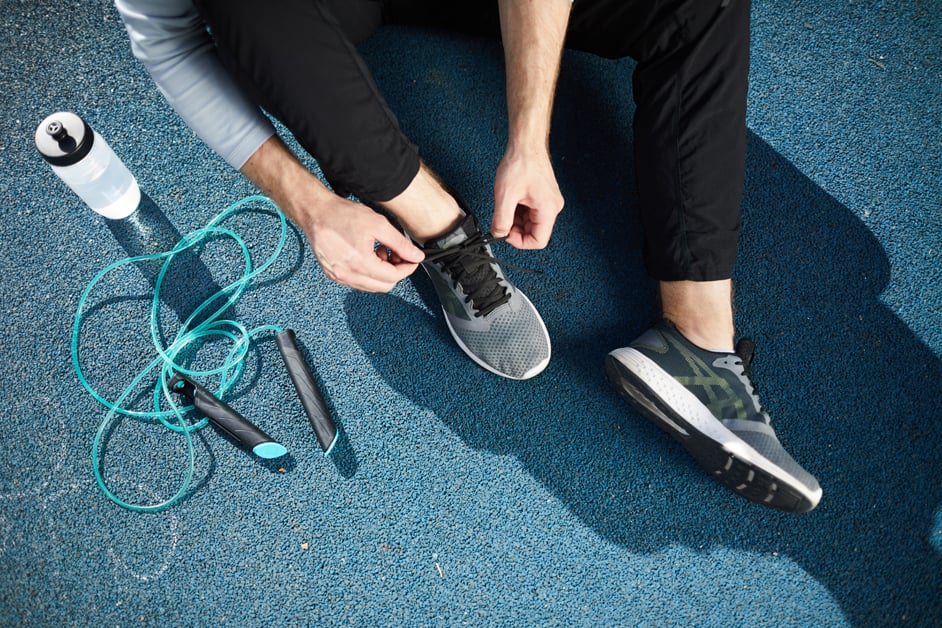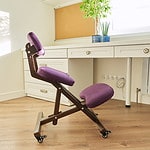Understand Your Knee Pain
Knee pain can be tricky. It is important to know the source of your pain. Is it arthritis? Injury? Flat feet? Once you understand what is causing your pain, you can pick the right shoes. This can help you find relief!
Identify the type of knee pain you have
Knee pain occurs in athletes and non-athletes. To find the best cross training shoes, it’s vital to recognize your type of knee pain.
One is patellofemoral pain syndrome (PFPS), more commonly known as “runner’s knee“. It happens when there’s extra pressure on the kneecap due to running or strain. Symptoms are a sharp or dull ache at the front of the knee and up your thigh. Shoes that support and cushion your feet, and keep them in their natural position, can help with PFPS by reducing stress on your knees when you run.
Tendinopathy is another cause of knee pain. It’s due to overuse injuries affecting muscles and bones around the knee. This can be because of poor flexibility or improper loading technique in sports or exercises. It leads to swelling, tenderness, and difficulty moving your knee joint(s). Cross-training shoes should have enhanced shock absorption in the heel and impact zones to reduce stress on affected tendon areas and reduce injury risk.
ACL injuries occur when a lot of twisting force is applied to the joint. This often happens with sudden stops and turns while playing sports or doing activities with explosive movements. A shoe with reinforced medial support is important when training after an ACL injury. It stabilizes weakened ligaments and provides comfort and flexibility until full strength is regained.
Think about these tips when you shop for cross-training shoes. They will help provide support and protection and keep you active, even with knee pain.
Consult with a doctor about your knee pain
Knee pain can have many reasons. A doctor can help you find the best way to deal with it. This can include rest, medicines for inflammation, physical therapy, or even surgery. Cross training shoes are designed to cushion and absorb shocks, decreasing knee pain due to running or other activities. Speak to your doctor about using cross training shoes to reduce knee pain.
Before buying new shoes, you want to address any issues that may be causing the pain. Instability or injury can cause discomfort while running or doing other activities. Strengthening exercises or orthotics can help. Weak muscles in the hip, glutes, quads, or hamstrings can also create issues. Strength training can help reduce knee pain.
When buying cross training shoes, make sure they have:
- Good arch support
- Shock absorbing soles
- Cushioning in the heel
- Fit properly
- Have enough toe room
- Suit your needs
Consider the Different Types of Cross-Training Shoes
Knee pain relief? Searching for cross-training shoes? No worries! There’s something for everyone. Stability shoes and lightweight trainers – the choices are plentiful. Let’s look into the types available, so a wise decision can be made on which best fits your needs.
Determine the type of cross-training you will be doing
When on the hunt for cross-training shoes, figure out what activities you’ll be doing. This will help guide your purchase. Most cross-training shoes are suitable for running, jumping, strength training, dancing, and aerobics. But, certain activities need specific features. These will provide support and stability, as well as avoid any damage to your knees and feet.
As an example, if you’ll be running a lot with your shoes, look for ones designed for running. They should have cushioning around the ankle to reduce pressure on the Achilles tendon. If lifting weights is the focus, then find a flat sole with no cushioning along the edges. This will give more rigidity and stability for movements like squats. If jumping is on the agenda, then shock absorbing foam cushioning is in order for protection every time you land after a jump.
Also, look for general features such as superior arch support, extra padding along pressure points, and breathability to reduce knee pain during any type of cross-training activity:
- Cushioning around the ankle to reduce pressure on the Achilles tendon.
- Flat sole with no cushioning along the edges.
- Shock absorbing foam cushioning.
- Superior arch support.
- Extra padding along pressure points.
- Breathability.
Research the different types of cross-training shoes available
Cross-trainers come in a variety of styles, shapes, and sizes. It’s essential to research the different types available and figure out which type is best for your needs and activities.
When selecting shoes for knee pain relief, cushioning and arch support are key. Make sure the cushioning provides shock absorption without compromising stability or responsiveness. Additionally, arch support can help with lateral movements like running or jumping jacks. Look for reinforced toe boxes and heal counters for toe protection and lateral support.
Other features to consider are breathability and weight. Breathable mesh uppers offer ventilation and lightweight construction. Finding an ideal trainer can be tricky – with some research, you’ll find the right pair!
Choose the Right Fit
Choosing a cross-training shoe for knee pain relief? The fit is key! Too big or too small can cause extra strain. Look for cushioning and arch support for running and other activities. With the right fit, you’ll get optimal comfort and stability, and minimise chances of further irritation or injury.
Measure your feet and find your size
To select a comfy pair of shoes, the right fit is important. Measure your feet for length and width. Put a ruler on the floor and stand on it. Make sure your heel is against the wall and the ruler against your longest toe or foot. To measure width, use the ruler across the forefoot (the widest part). Record the measurement in inches or centimeters. Use both measurements to find the right size. If two sizes fit, go for the wider one. Choosing a shoe too small can be uncomfortable when walking or exercising.
Try on different types of shoes to find the right fit
Choosing the correct shoes is vital for your daily wardrobe. Not only should they be fashionable, but they must also give you the correct fit and comfort you need to be comfortable throughout the day.
To work out the size and type of shoe for you, it’s better to try on various shoes in different sizes. This can help you narrow down your options and choose which pair fits your feet the best. Here are some tips:
- Measure both feet from heel to toe and write down your measurements so you know what size will fit best.
- Get a half size larger if one foot is larger than the other; this will prevent any tight spots or blisters when wearing them.
- Take into consideration any embellishments along the sides of the shoe, such as straps or buckles that may make them fit tighter than usual in certain areas.
- Wear socks similar to what you would usually wear with those shoes when trying them on for an accurate feel for how they will fit over time.
- Go for a walk in each pair before making a decision; it’s easy to tell at this point which pair is more comfortable than the other due to its size or shape.
- Always buy shoes from a store with an exchange policy, so you can return any ill-fitting pairs without any trouble.
Look for the Right Features
Selecting the best cross-training shoes for knee pain relief is important. Need to find the right features. Shoes must have cushioning system. This will provide comfort, support and arch support. Rubber outsole helps with grip and flexibility. Identify what activity you’ll be doing. This will help choose the right shoes.
In this article, we’ll discuss features for the best cross-training shoes for knee pain relief:
Look for shoes with cushioning and arch support
When selecting a shoe, consider the cushioning, arch support, and traction. Go for cushioning and arch support in both heel and forefoot sections. This offers shock absorption when you walk or run.
Choose shoes with stability and secure lacing systems. This helps to avoid blisters, pressure points, pain, and injury. Look for breathable materials like mesh or synthetic suede. This keeps feet cooler in hot weather.
When selecting running shoes, pick those with padded collars around the ankle. This offers extra padding and prevents rubbing against the tongue. A good lacing system prevents laces from loosening while running. Look for laces that reach the notch near the midsole or near the base of the big toe.
Make sure you have proper arch support. Most running or walking shoes have a well-defined inward curve in the midsole for comfort. Extra cushioning underfoot protects sensitive areas. Look for rearfoot stability wraps, outsole durability, breathable uppers, and toe protection.
Look for shoes with a wide toe box
When selecting shoes, go for a style with a wide toe box. This gives your toes enough room to spread out, ensuring comfort and stability when walking or running. Pointy or tight toe boxes can restrict toes, leading to discomfort and even injury. A wide toe box also makes room for irregularities in foot shape and size.
Shoes with Velcro closures are beneficial too, as they provide adjustable fits that won’t be as tight as laces. Always try on shoes while wearing the socks you plan on exercising in; this will ensure the best fit.
Look for shoes with a good grip
When shopping for shoes, look for ones with rubber or leather materials. These provide the best traction. Synthetic leather options are less reliable. Look for outward-facing grooves that can displace water and help you stay balanced in wet conditions.
Choose soles made of materials that give you grip in different environments. Deep lugs and treads help support and stability even when surfaces become slick.
For the upper material, sturdy mesh or fabric offer breathability. Search for models with neoprene collars or waterproof materials if you need protection from puddles or splashing water.
Consider the Price
Price is key when selecting cross-training shoes to help with knee pain. You don’t have to spend a fortune, but you should get value for your money. A pricier shoe may be worth it if it has the features and support to avoid knee pain.
Set a budget for your shoes
Before you shop for the best cross-training shoes to relieve knee pain, set a budget. Cross-training shoes can be cheap or expensive. Decide what you are willing to spend. Consider your needs. Set a sensible budget. It will give you the best value.
Research and compare different styles and brands. Read reviews from other customers. Pay attention to customer complaints and feedback. This can help you decide if these shoes are good for your knee pain.
Lastly, buy from a reputable site. Amazon or Zappos are good choices. They have customer service options if any issues arise.
Compare prices of different brands of shoes
Do research online to compare prices of shoes from different brands. Consider quality, design, shipping cost, return policies, and customer service ratings. Look for sales or promotions when shopping. Check for discounts or special pricing when you buy in bulk or if you are a frequent shopper. Always compare prices across websites and online retailers to get the best deal.
Look for sales or discounts to save money
Do some research before buying cross-training shoes to relieve knee pain. Don’t just go for the cheapest option, as it likely won’t last as long or provide the best comfort and support. Look for quality at an affordable price. Check online stores and discount outlets, compare prices online and watch for sales or discounts. Many stores offer deals after holidays like Labor Day or Black Friday.
Shopping around takes time, but it’s worth it. Don’t miss out on excellent shoes at half the cost! Keep an eye out for good deals:
- Check online stores and discount outlets.
- Compare prices online.
- Watch for sales or discounts.
- Look out for deals after holidays like Labor Day or Black Friday.
Frequently Asked Questions
Q1: What features should I look for in a cross-training shoe for knee pain relief?
A1: When searching for cross-training shoes for knee pain relief, look for shoes that offer cushioning, shock absorption and arch support. Shoes with a wide toe box and flexible sole can also help reduce pressure on the knees.
Q2: Should I wear a knee brace with my cross-training shoes?
A2: Wearing a knee brace may help to provide additional support and stability for your knees when exercising. However, it is important to speak with a healthcare professional to determine if wearing a knee brace is right for you.
Q3: Are there any other tips for choosing the best cross-training shoes for knee pain relief?
A3: When shopping for cross-training shoes, make sure to wear the same type of socks you would normally wear when exercising and to try on both shoes and walk around the store. It is also recommended to replace your shoes every 300-400 miles or when the cushioning and support is no longer adequate.





